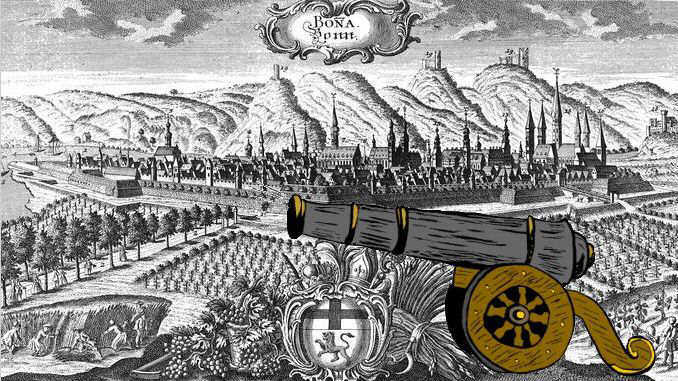
Both rulers in the Rhineland, the Duke of Berg and as the Prince-Elector of Cologne, were drawn into the European wars of succession. Holy Roman Empire, at the end of the 17th century. After the Thirty Years’ War, large parts of Central Europe lay in ashes.
The outstanding person of the early age of absolutism was Louis XIV of France (1643-1715), the “Sun King”. His power was overwhelming, so the quote “The state is me” was attributed to him.
Powerful and less powerful rulers
An emperor of the Holy Roman Empire at that time could not have said this about himself. Since the Peace of Westphalia in 1648, German princes had reigned like kings in their states, the map of the Empire resembled a mosaic and above all the electorate princes had a forceful position. The emperor and the princes tried to impose an absolutist kingdom and to enlarge their territories, whether by advantageous marriages or by force of arms. Those who had enough money raised a standing army, that is, an army of professional soldiers always ready to fight.
War of the Palatinate Succession
In his struggle to obtain predominance in Europe, Louis XIV of France repeatedly imposed wars on his neighboring countries. He did not seem to care about his own people’s pain and hunger (a theme in “The Man in the Iron Mask”).
Palatine succession
In 1688 Louis claimed the Palatinate crown. When Prince Elector of the Palatinate, at the same time Duke of Berg, did not give in, French troops occupied the Palatinate and neighboring regions. The War of the Palatine Succession (1688-1697) broke out. Almost all European rulers and many German princes joined forces against Louis XIV.
Back then in the Siebengebirge
In the Archbishopric of Cologne, however, Louis had an ally. His candidate for the Archbishop’s position got more votes than the Emperor’s, Joseph Clemens of the Wittelsbach family. Immediately he moved into his residence at Bonn and had French troops march into the region. Bonn and Siegburg were occupied. That brought Emperor Leopold I and the Pope into the arena, and with their help Joseph Clemens became Archbishop on September 20, 1688.
Siege of Bonn
The imperial troops commanded by Frederick III, Prince Elector and Duke of Brandenburg-Prussia, besieged Bonn in summer 1689. They bombed the city for about three months until it capitulated in October 1689. A lot of damage had been done.
Königswinter and other villages go up in flames
On March 23, 1689, about 600 French mercenaries crossed the Rhine, sacked, plundered and burnt Oberkassel and Dollendorf. Then they marched to Königswinter and destroyed almost the entire town, shortly after also the nearby village of Rhöndorf. Then finally the soldiers from Brandenburg under Frederick III were there and chased the French mercenaries. In Bonn, the French could hold out until October 12, 1689, then the Brandenburgers conquered the city.
Scorched earth in the Palatinate
Also in the Palatinate the army of Louis XIV was on the brick of defeat. Before retiring, they plundered and burned down entire villages and cities. When finally peace was made in 1697 in Rijswijk, France did not obtain anything, but large regions in the west of the Empire lay in ashes.
War of the Spanish Succession
Yet, only a couple of years later the War of the Spanish Succession (1701-1714) broke out. Again the Elector-Archbishop Joseph Clemens of Cologne sided with Louis XIV. He and his older brother Maximilian II Emanuel of Bavaria probably expected a return favor, the Spanish Netherlands and a king’s crown for their family.
Thereupon, in 1702 Bonn was again occupied by imperial troops from Brandenburg under Frederick I. Joseph Clemens fled into exile in France and was outlawed. Again, imperial troops bombed Bonn.
The French troops faced two military geniuses: Prince Eugene of Savoy and John Churchill, the Duke of Marlborough. Louis XIV was on the verge of defeat, his people were starving and powerless, his state was almost ruined.
Then Emperor Leopold I died in Vienna, and his eldest son and successor Joseph I did not survive him for long. So, Charles inherited the imperial crown, the same Charles for whom the alliance had fought. But they had not fought a French supremacy to tolerate one of the Habsburgs now. The alliance fell apart and made peace with France. Ludwig’s grandson received Spain, Austria the Spanish Netherlands; Charles became emperor, as Charles VI (1711-1740).
Rococo in Bonn
Joseph Clemens could to return to his residence in Bonn. There he built the rococo castle of Poppelsdorf. Even more famous is his successor, Clemens August of Bavaria (1700-1761), who built the castles Augustusburg and Falkenlust in the city of Brühl. Today they are a World Heritage Site.
Absolute Monarchy
Although the dukes fought Louis XIV – his sumptuous court life at Versailles impressed them greatly, and who had the means created his own little Versailles. Most likely, they didn’t think of their subjects whose taxes and hard work financed their courts, campaigns, and reconstruction.
It was the era of absolutist rulers. Since the Peace of Westphalia of 1648, the princes ruled as sovereigns in their states. Who had the means raised a standing army, that is an army of professional soldiers who were always ready for battle. Later, same rulers even rented entire regiments.
The peace in Europe did not last long. Frederick II of Prussia (1740-1786) waged three wars of succession against Austria and its allies. The Seven Years War (1756-1763) brought Prussia close to the edge, but in the end it was next to England, France, Austria and Russia, the fifth major power in Europe.
https://en.wikipedia.org/wiki/Poppelsdorf_Palace
Early Modern Period
Intro Early Modern Period | Lutherans, Calvinists, Anapabtists | Absolutism and wars of succession

Be the first to comment